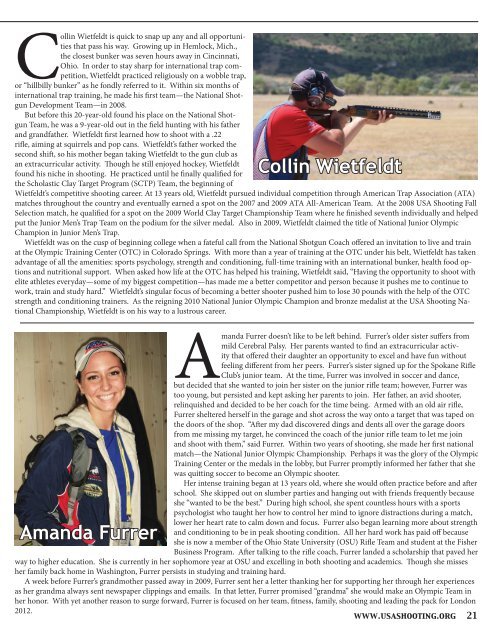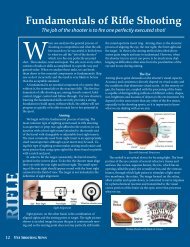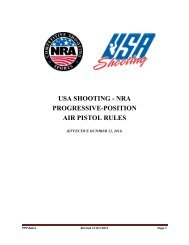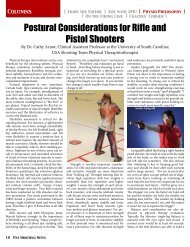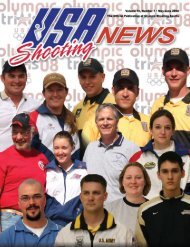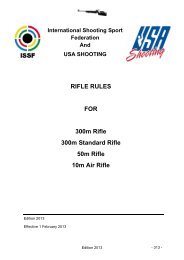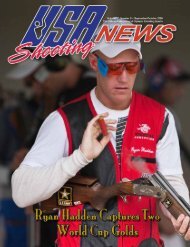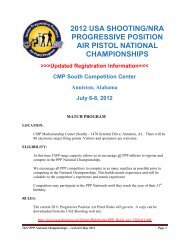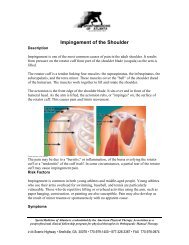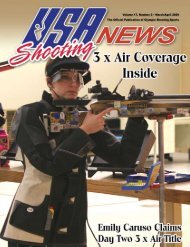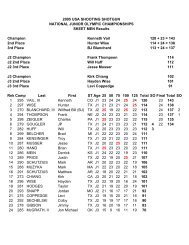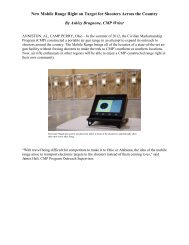November/December 2010: Volume 18, Number 6 - USA Shooting
November/December 2010: Volume 18, Number 6 - USA Shooting
November/December 2010: Volume 18, Number 6 - USA Shooting
- No tags were found...
You also want an ePaper? Increase the reach of your titles
YUMPU automatically turns print PDFs into web optimized ePapers that Google loves.
Collin Wietfeldt is quick to snap up any and all opportunitiesthat pass his way. Growing up in Hemlock, Mich.,the closest bunker was seven hours away in Cincinnati,Ohio. In order to stay sharp for international trap competition,Wietfeldt practiced religiously on a wobble trap,or “hillbilly bunker” as he fondly referred to it. Within six months ofinternational trap training, he made his first team—the National ShotgunDevelopment Team—in 2008.But before this 20-year-old found his place on the National ShotgunTeam, he was a 9-year-old out in the field hunting with his fatherand grandfather. Wietfeldt first learned how to shoot with a .22rifle, aiming at squirrels and pop cans. Wietfeldt’s father worked thesecond shift, so his mother began taking Wietfeldt to the gun club asan extracurricular activity. Though he still enjoyed hockey, Wietfeldtfound his niche in shooting. He practiced until he finally qualified forCollin Wietfeldtthe Scholastic Clay Target Program (SCTP) Team, the beginning ofWietfeldt’s competitive shooting career. At 13 years old, Wietfeldt pursued individual competition through American Trap Association (ATA)matches throughout the country and eventually earned a spot on the 2007 and 2009 ATA All-American Team. At the 2008 <strong>USA</strong> <strong>Shooting</strong> FallSelection match, he qualified for a spot on the 2009 World Clay Target Championship Team where he finished seventh individually and helpedput the Junior Men’s Trap Team on the podium for the silver medal. Also in 2009, Wietfeldt claimed the title of National Junior OlympicChampion in Junior Men’s Trap.Wietfeldt was on the cusp of beginning college when a fateful call from the National Shotgun Coach offered an invitation to live and trainat the Olympic Training Center (OTC) in Colorado Springs. With more than a year of training at the OTC under his belt, Wietfeldt has takenadvantage of all the amenities: sports psychology, strength and conditioning, full-time training with an international bunker, health food optionsand nutritional support. When asked how life at the OTC has helped his training, Wietfeldt said, “Having the opportunity to shoot withelite athletes everyday—some of my biggest competition—has made me a better competitor and person because it pushes me to continue towork, train and study hard.” Wietfeldt’s singular focus of becoming a better shooter pushed him to lose 30 pounds with the help of the OTCstrength and conditioning trainers. As the reigning <strong>2010</strong> National Junior Olympic Champion and bronze medalist at the <strong>USA</strong> <strong>Shooting</strong> NationalChampionship, Wietfeldt is on his way to a lustrous career.Amanda Furrer doesn’t like to be left behind. Furrer’s older sister suffers frommild Cerebral Palsy. Her parents wanted to find an extracurricular activitythat offered their daughter an opportunity to excel and have fun withoutfeeling different from her peers. Furrer’s sister signed up for the Spokane RifleClub’s junior team. At the time, Furrer was involved in soccer and dance,but decided that she wanted to join her sister on the junior rifle team; however, Furrer wastoo young, but persisted and kept asking her parents to join. Her father, an avid shooter,relinquished and decided to be her coach for the time being. Armed with an old air rifle,Furrer sheltered herself in the garage and shot across the way onto a target that was taped onthe doors of the shop. “After my dad discovered dings and dents all over the garage doorsfrom me missing my target, he convinced the coach of the junior rifle team to let me joinand shoot with them,” said Furrer. Within two years of shooting, she made her first nationalmatch—the National Junior Olympic Championship. Perhaps it was the glory of the OlympicTraining Center or the medals in the lobby, but Furrer promptly informed her father that shewas quitting soccer to become an Olympic shooter.Her intense training began at 13 years old, where she would often practice before and afterschool. She skipped out on slumber parties and hanging out with friends frequently becauseshe “wanted to be the best.” During high school, she spent countless hours with a sportspsychologist who taught her how to control her mind to ignore distractions during a match,lower her heart rate to calm down and focus. Furrer also began learning more about strengthand conditioning to be in peak shooting condition. All her hard work has paid off becauseAmanda Furrershe is now a member of the Ohio State University (OSU) Rifle Team and student at the FisherBusiness Program. After talking to the rifle coach, Furrer landed a scholarship that paved herway to higher education. She is currently in her sophomore year at OSU and excelling in both shooting and academics. Though she missesher family back home in Washington, Furrer persists in studying and training hard.A week before Furrer’s grandmother passed away in 2009, Furrer sent her a letter thanking her for supporting her through her experiencesas her grandma always sent newspaper clippings and emails. In that letter, Furrer promised “grandma” she would make an Olympic Team inher honor. With yet another reason to surge forward, Furrer is focused on her team, fitness, family, shooting and leading the pack for London2012.www.usashooting.org 21Nov-Dec Issue <strong>2010</strong>.indd 2111/8/10 9:22 PM


